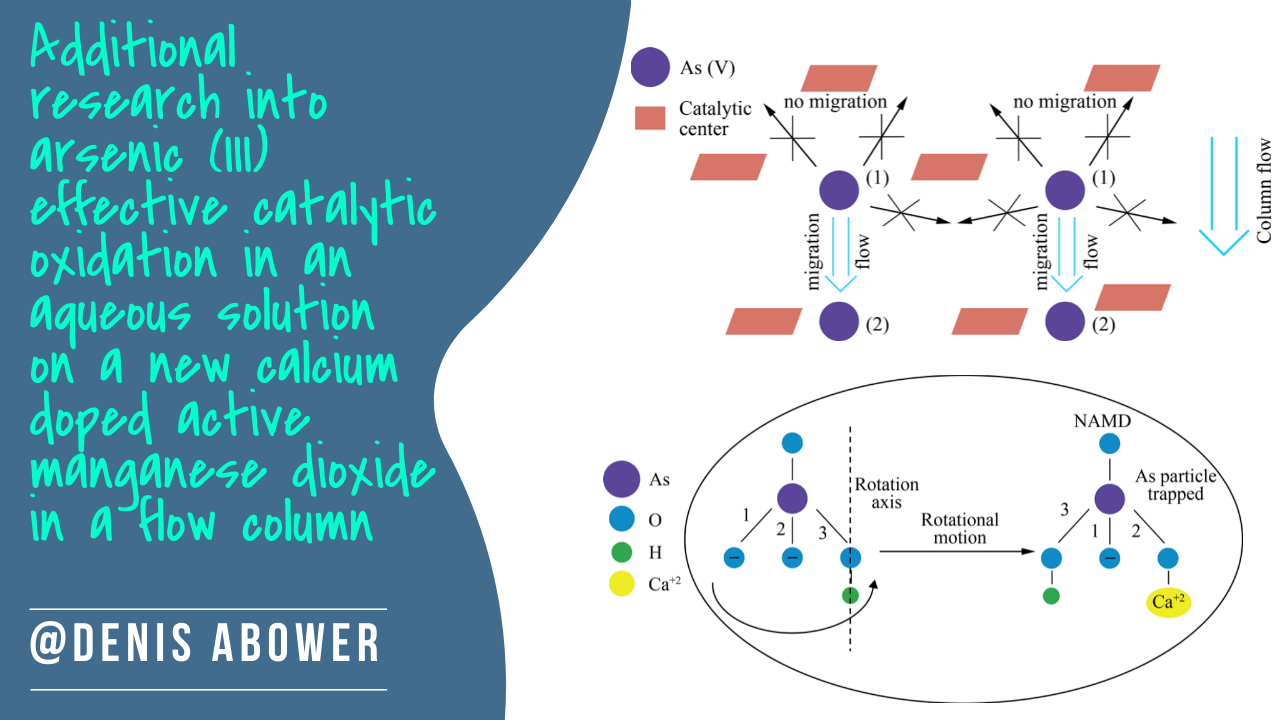Additional research into arsenic (III) effective catalytic oxidation in an aqueous solution on a new calcium doped active manganese dioxide in a flow column
DOI:
https://doi.org/10.15587/2706-5448.2024.310420Keywords:
groundwater, water purification from arsenic, arsenic (III) oxidation, arsenic (III) oxidation catalysts, arsenic sorptionAbstract
In many places in the world, groundwater contains arsenic compounds. To purify water containing arsenic effectively, arsenic (III) compounds must be oxidised. The subject of this study is oxidation of arsenic (III) compounds in an aqueous solution in a flow column mode.
The industrial arsenic oxidation technology involving aggressive oxidising agents such as chlorine or ozone, which is used most commonly today, has a number of serious disadvantages. The most problematic include extremely high risks for human health and the environment, the process cost and overall complexity. Catalytic oxidation of arsenic (III) compounds with atmospheric oxygen is an alternative that is free from the above disadvantages. Previously, the author studied the process of effective catalytic oxidation of arsenic (III) on the new active manganese dioxide (NADM) he had synthesised.
Later, however, it turned out that NADM has a significant drawback: during prolonged flow column stops, its catalytic activity drops sharply. This work proposes both a theoretical justification for and a solution to this problem. A new calcium-doped active manganese dioxide NADM-Ca0.5 was synthesised. It was shown that NADM-Ca0.5 demonstrates high catalytic activity towards arsenic (III). The fact that flow column long stops do not affect its catalytic activity was also experimentally confirmed. On the basis of the study results, some theoretical aspects are also discussed of the mechanism for catalytic oxidation of arsenic (III) with oxygen on active manganese dioxide in an aqueous solution.
For successful industrial implementation of the technology for catalytic oxidation of arsenic (III) compounds on NADM-Ca0.5, experimental work on pilot plants in the field is required and further laboratory research is needed in order to develop a detailed theoretical basis for the mechanism of catalytic oxidation of arsenic in aqueous solutions.
The results of this work are of interest for both industrial companies specialising in water purification from arsenic compounds, and scientists and researchers studying catalytic oxidation of arsenic (III), as well as heterogeneous catalytic oxidation with oxygen in general.
References
- Shaji, E., Santosh, M., Sarath, K. V., Prakash, P., Deepchand, V., Divya, B. V. (2021). Arsenic contamination of groundwater: A global synopsis with focus on the Indian Peninsula. Geoscience Frontiers, 12 (3), 101079. https://doi.org/10.1016/j.gsf.2020.08.015
- Rajakovic, L., Rajakovic-Ognjanovic, V. (2018). Arsenic in Water: Determination and Removal. Arsenic – Analytical and Toxicological Studies. https://doi.org/10.5772/intechopen.75531
- Hering, J. G., Katsoyiannis, I. A., Theoduloz, G. A., Berg, M., Hug, S. J. (2017). Arsenic Removal from Drinking Water: Experiences with Technologies and Constraints in Practice. Journal of Environmental Engineering, 143 (5). https://doi.org/10.1061/(asce)ee.1943-7870.0001225
- Ghurye, G., Clifford, D. (2004). As(III) oxidation using chemical and solid‐phase oxidants. Journal AWWA, 96 (1), 84–96. https://doi.org/10.1002/j.1551-8833.2004.tb10536.x
- Zhang, W., Singh, P., Issa, T. B. (2011). Arsenic(III) Remediation from Contaminated Water by Oxidation and Fe/Al Co-Precipitation. Journal of Water Resource and Protection, 3 (9), 655–660. https://doi.org/10.4236/jwarp.2011.39075
- Ghurye, G., Clifford, D. (2001). Laboratory study on the oxidation of Arsenic III to Arsenic. University of Houston.
- Pokhrel, R., Goetz, M. K., Shaner, S. E., Wu, X., Stahl, S. S. (2015). The «Best Catalyst» for Water Oxidation Depends on the Oxidation Method Employed: A Case Study of Manganese Oxides. Journal of the American Chemical Society, 137 (26), 8384–8387. https://doi.org/10.1021/jacs.5b05093
- Abower, D. (2024). Research into arsenic (III) effective catalytic oxidation in an aqueous solution on a new active manganese dioxide in a flow column. Technology Audit and Production Reserves, 1 (3 (75)), 15–23. https://doi.org/10.15587/2706-5448.2024.298969
- Kariakin, Iu. V. (1947). Chistye khimicheskie reaktivy. GNTIKhL, 574.
- Murray, J. W. (1974). The surface chemistry of hydrous manganese dioxide. Journal of Colloid and Interface Science, 46 (3), 357–371. https://doi.org/10.1016/0021-9797(74)90045-9
- Feistel, U., Otter, P., Kunz, S., Grischek, T., Feller, J. (2016). Field tests of a small pilot plant for the removal of arsenic in groundwater using coagulation and filtering. Journal of Water Process Engineering, 14, 77–85. https://doi.org/10.1016/j.jwpe.2016.10.006
- Johnston, R., Heijnen, H. Safe Water Technology for Arsenic Removal Environmental Health Advisor. Bangladesh. Johnston and Heijnen: Safe Water Technology for Arsenic Removal
- Oscarson, D. W., Huang, P. M., Defosse, C., Herbillon, A. (1981). Oxidative power of Mn(IV) and Fe(III) oxides with respect to As(III) in terrestrial and aquatic environments. Nature, 291 (5810), 50–51. https://doi.org/10.1038/291050a0
- Tran, L. (2017). Arsenic removal using manganese oxide for arsenic oxidation process. Case study – Skovby waterworks. Denmark Bachelor’s thesis Environmental Engineering.

Downloads
Published
How to Cite
Issue
Section
License
Copyright (c) 2024 Denis Abower

This work is licensed under a Creative Commons Attribution 4.0 International License.
The consolidation and conditions for the transfer of copyright (identification of authorship) is carried out in the License Agreement. In particular, the authors reserve the right to the authorship of their manuscript and transfer the first publication of this work to the journal under the terms of the Creative Commons CC BY license. At the same time, they have the right to conclude on their own additional agreements concerning the non-exclusive distribution of the work in the form in which it was published by this journal, but provided that the link to the first publication of the article in this journal is preserved.







